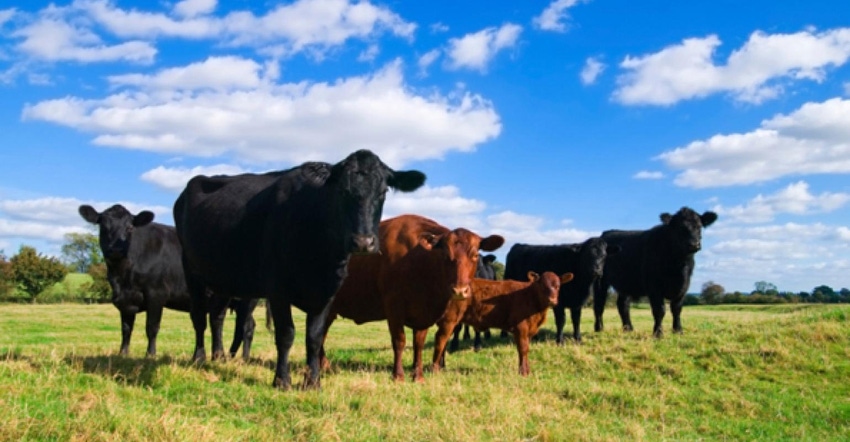8 Tips to plan for winter grazing
Don't wait until snow is on the ground, start planning your stockpiles now.
August 11, 2022

It’s hard to think about winter feeding on hot summer days, but now is the time to begin that planning process. High feed costs coupled with high fuel costs makes extended grazing options important to consider. Many cattlemen in northern Iowa tell me winter grazing isn’t an option, but with a little planning now extending grazing a month or more can be done anywhere. Here are a few options to consider.
Stockpiling pastures is one option, provided you have adequate pasture acres to set aside from August first and graze after a killing freeze. Fescue is the best stockpile option for cool seasons since it tends to stand upright after a freeze. Other cool season grasses should be grazed soon after a freeze since they don’t maintain their upright stance well. Most producers don’t have extra pasture, but hay fields can be an option too. With the high price of fuel, consider letting the last cutting of hay grow and graze it in the fall. Alfalfa hay should be grazed with 7-10 days after a killing frost to ensure that the risk of bloat potential subsides but leaf loss doesn’t impact quality.
Summer annuals like sudangrass, sorghumXsudangrass, or millets stockpile well and maintain their upright stance following a killing freeze. Again, allow it to grow from about August 1 until freeze for adequate forage. Sudangrass and sorghumXsudan do have the potential for prussic acid poisoning so stay off it from the first frost until about a week after a full killing freeze (below 28’ for 3+ hours). For best utilization of the forage, strip graze with electric fence and move the fence every couple of days. Iowa research shows we can grow 3-5+ tons of dry matter per acre from summer annuals which should provide about 80-130 cow grazing days per acre at 50% utilization rate.
Swath grazing is a common method used in Canada, and an ISU study on swath grazing sorghumXsudangrass shows it works in Iowa as well. The second cutting of sorghumXsudangrass was stockpiled, mowed and windrowed about a week prior to late December grazing, and provided about 115 cow grazing days per acre. Cows stayed on the swaths through mid-February with no negative consequences from snow or ice. Strip grazing the swaths resulted in 70% utilization of the forage available so very little residue was left in the field for the next crop year and no additional tillage was needed to remove the residue.
Seed winter annuals (aka cover crops) for winter and early spring grazing. For maximum forage growth, drill winter annuals following corn silage or early soybean harvest. Oats, triticale and brassicas result in the most fall grazing growth while winter cereal rye and triticale provide the most growth and earliest available spring grazing.
Grazing standing corn is an option, although more difficult to justify with high grain prices. Some grain needs to be harvested to set up the strip fencing and reduce the total grain left in the field to get a better ratio of grain to forage. This MUST be strip grazed to reduce acidosis risk.
Bale grazing is a method of winter grazing where bales are distributed throughout a field and temporary fencing is used to allocate adequate forage for a day or two. Cows spread manure across the field instead of in one location, and the need to start a tractor daily is reduced.
Cornstalk grazing has been a major feed source across Iowa for early winter feed, but we only utilize less than a quarter of the stalks available in the state. The nutrition in stalks is highest in the ears, leaves and husks, and once they are consumed or deteriorated by weather, the feed value drops rapidly. In continuous grazed corn fields cows will select the ears, leaves and husks quickly, so any type of strip or rotational grazing increases the grazing days from corn fields. For larger herds, consider putting all cattle in one group, start grazing in the first fields harvested or the farthest from home, and move cows to a new field when the leaves and husks are consumed. For smaller herds, consider strip grazing with electric fences and sizing your strips so cows move every week or two to a new area.
Cornstalk swath grazing isn’t for the faint of heart, but for those willing to try something ‘outside the box’ this might be an option for a few acres close to the winter feeding area. Shut off the chaff spreader on your combine to create a swath of leaves and husks following grain harvest, then strip graze those in January where you can supplement with additional feed if needed. Just be sure your grazing density on the strips is intense enough to utilize all the forage in the windrow and not leave too much behind for spring planting season.
These are just a few options to extend the grazing season and reduce stored feed costs. Remember for every week we keep cows grazing offsets $13 per cow in feed at $100/ton hay plus the price of diesel used to deliver that hay. For many operations, that’s about a 2% reduction in total cow costs for every week grazing is extended. If you need additional help in calculating winter grazing needs, contact your regional beef specialist.
Source: Iowa State University, who is solely responsible for the information provided and is wholly owned by the source. Informa Business Media and all its subsidiaries are not responsible for any of the content contained in this information asset.
You May Also Like


.png?width=300&auto=webp&quality=80&disable=upscale)
